Advertisements
Advertisements
Question
Describe how a potentiometer is used to compare the EMFs of two cells by connecting the cells individually.
Solution 1
A stable emf E battery is used to create a potential gradient V/L along a potentiometer wire, where V ≡ potential difference across the length L of the wire.
The positive terminals of the cells, whose emf's (E1 and E2) are to be compared, are connected to the high potential terminal A. A two-way key connects the negative terminals of the cells to a galvanometer G. The galvanometer's other end is attached to a pencil jockey. The emf E must be greater than the emfs E1 and E2.

Comparison of two emf's using a potentiometer by the direct method
The cell with emf E1 is brought into the circuit by connecting points P and C.
The jockey is tapped along the wire to find the null point D, which is located at a distance of l1 from A. Then,
E1 = `l_1("V"/"L")`
w, without changing the potential gradient (i.e., without changing the rheostat setting) point Q (instead of P) is connected to C, bringing the cell with emf E2 into the circuit. Let its null point D' be at a distance l2 from A, so that
E2 = `l_2("V"/"L")`
As a result, `"E"_1/"E"_2` can be calculated by measuring the corresponding null lengths l1 and l2. Using the rheostat, the experiment is repeated for different potential gradients.
Solution 2
- A potentiometer circuit is set up by connecting a battery of emf (E), with a key (K) and a rheostat such that point A is at a higher potential than point B.
- The cells whose EMFs are to be compared are connected with their positive terminals at point A and negative terminals to the extreme terminals of a two-way key K1 and K2.
- The central terminal of the two ways key is connected to a galvanometer. The other end of the galvanometer is connected to a jockey (J).
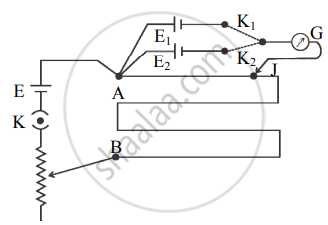
- Key K is closed and then, key K1 is closed and key K2 is kept open. Therefore, the cell of emf E1 comes into the circuit.
- The null point is obtained by touching the jockey at various points on the potentiometer wire AB.
- Let l1 be the length of the wire between the null point and point A.
Here, l1 corresponds to emf E1 of the cell. Therefore,
E1 = K l1 ….(1)
where K is the potential gradient along the potentiometer wire. - Now key K1 is kept open and key K2 is closed. The cell of emf E2 now comes in the circuit. Again, the null point is obtained with the help of the Jockey.
- Let l2 be the length of the wire between the null point and point A.
Here l2 corresponds to the emf E2 of the cell.
∴ E2 = K l2 ….(2) - Dividing equation (1) by equation (2),
`"E"_1/"E"_2 = "l"_1/"l"_2`
Thus, the EMFs of the two cells can be compared and if any one of the EMFs is known, the other can be determined.
RELATED QUESTIONS
State the principle of working of a potentiometer.
State the advantages of potentiometer over voltmeter.
In the given circuit, with steady current, calculate the potential drop across the capacitor and the charge stored in it.

In the given circuit in the steady state, obtain the expressions for (a) the potential drop (b) the charge and (c) the energy stored in the capacitor, C.

A potentiometer wire of length 1 m has a resistance of 5 Ω. It is connected to a 8 V battery in series with a resistance of 15 Ω. Determine the emf of the primary cell which gives a balance point at 60 cm.
Write the principle of working of a potentiometer. Describe briefly, with the help of a circuit diagram, how a potentiometer is used to determine the internal resistance of a given cell.
Draw a labelled circuit diagram of a potentiometer to measure the internal resistance ‘r’ of a cell. Write the working formula (derivation is not required).
Draw a labelled circuit diagram of a potentiometer to compare emfs of two cells. Write the working formula (Derivation not required).
When the balance point is obtained in the potentiometer, a current is drawn from ______.
Define or describe a Potentiometer.
What are the disadvantages of a potentiometer?
Describe with the help of a neat circuit diagram how you will determine the internal resistance of a cell by using a potentiometer. Derive the necessary formula.
A battery of emf 4 volt and internal resistance 1 Ω is connected in parallel with another battery of emf 1 V and internal resistance 1 Ω (with their like poles connected together). The combination is used to send current through an external resistance of 2 Ω. Calculate the current through the external resistance.
Find the equivalent resistance between the terminals of A and B in the network shown in the figure below given that the resistance of each resistor is 10 ohm.
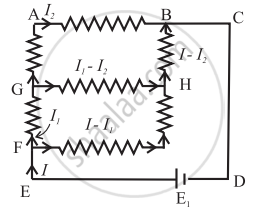
The resistance of a potentiometer wire is 8 Ω and its length is 8 m. A resistance box and a 2 V battery are connected in series with iL What should be the resistance in the box if it is desired to have a potential drop of 1 µV/mm?
When two cells of emf's E1 and E2 are connected in series so as to assist each other, their balancing length on a potentiometer wire is found to be 2.7 m. When the cells are connected in series so as to oppose each other, the balancing length is found to be 0.3 m. Compare the emf's of the two cells.
When the null point is obtained in the potentiometer, the current is drawn from the ______
What are the disadvantages of a potentiometer over a voltmeter?
A cell of e.m.f 1.5V and negligible internal resistance is connected in series with a potential meter of length 10 m and the total resistance of 20 Ω. What resistance should be introduced in the resistance box such that the potential drop across the potentiometer is one microvolt per cm of the wire?
Two cells having unknown emfs E1 and E2 (E1 > E2) are connected in potentiometer circuit, so as to assist each other. The null point obtained is at 490 cm from the higher potential end. When cell E2 is connected, so as to oppose cell E1, the null point is obtained at 90 cm from the same end. The ratio of the emfs of two cells `("E"_1/"E"_2)` is ______.
A potentiometer is an ideal device for measuring potential difference because ______.
A potentiometer wire of length 100 cm has a resistance of 10 `Omega.` It is connected in series with a resistance and an accumulator of e.m.f 2 V and of negligible internal resistance. A source of e.m.f 10 mV is balanced against a 40 cm length of the potentiometer wire. The value of the external resistance is ____________.
The length of a wire of a potentiometer is 100 cm, and the e.m.f of its standard cell is E volt. It is employed to measure the e.m.f of a battery whose internal resistance is 0.5 `Omega` If the balance point is obtained at `l`= 30 cm from the positive end, the e.m.f of the battery is ____________.
where 'i' is the current in the potentiometer
When two cells of e.m.f 1.5 V and 1.1 V connected in series are balanced on a potentiometer, the balancing length is 260 cm. The balancing length, when they are connected in opposition is (in cm) ____________.
A potentiometer is used to measure the potential difference between A and B, the null point is obtained at 0.9 m. Now the potential difference between A and C is measured, the null point is obtained at 0.3 m. The ratio `E_2/E_1` is (E1 > E2) ______

A potentiometer wire has a length of 4m and resistance of 5Ω. It is connected in series with 495 Ω resistance and a cell of e.m.f. 4V. The potential gradient along the wire is ______
Two students X and Y perform potentiometer experiment separately and null point was obtained as shown in diagram. During the experiment, ______.
- X increases the value of R (resistance)
- Y decreases the value of S (resistance)
The position of null point obtained by students X and Y respectively.
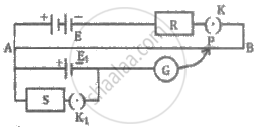
A potentiometer wire is 4 m long and a potential difference of 3 V is maintained between the ends. The e.m.f. of the cell which balances against a length of 100 cm of the potentiometer wire is ______
A potentiometer wire of length 'L' and a resistance 'r' are connected in series with a battery of E.M.F. 'E0' and a resistance 'r1'. A cell of unknown E.M.F, 'E' is balanced at a length 'ℓ' of the potentiometer wire. The unknown E.M.F. E is given by ______
The sensitivity of the potentiometer can be increased by ______.
A battery is connected with a potentiometer wire. The internal resistance of the battery is negligible. If the length of the potentiometer wire of the same material and radius is doubled then ______.
A potentiometer wire is 100 cm long and a constant potential difference is maintained across it. Two cells are connected in series first to support one another and then in opposite direction. The balance points are obtained at 50 cm and 10 cm from the positive end of the wire in the two cases. The ratio of emf's is ______.
The best instrument for accurate measurement of EMF of a cell is ____________.
The value of current I in the network shown in fig.
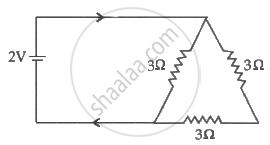
Specific resistance of a conductor increase with.
The instrument among the following which measures the e.m.f of a cell most accurately is ______
In a potentiometer circuit a cell of EMF 1.5 V gives balance point at 36 cm length of wire. If another cell of EMF 2.5 V replaces the first cell, then at what length of the wire, the balance point occurs?
Consider a simple circuit shown in figure ![]() stands for a variable resistance R′. R′ can vary from R0 to infinity. r is internal resistance of the battery (r << R << R0).
stands for a variable resistance R′. R′ can vary from R0 to infinity. r is internal resistance of the battery (r << R << R0).
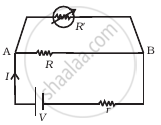
- Potential drop across AB is nearly constant as R ′ is varied.
- Current through R′ is nearly a constant as R ′ is varied.
- Current I depends sensitively on R′.
- `I ≥ V/(r + R)` always.
AB is a potentiometer wire (Figure). If the value of R is increased, in which direction will the balance point J shift?
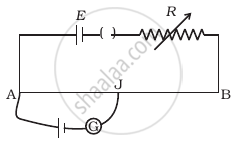
While doing an experiment with potentiometer (Figure) it was found that the deflection is one sided and (i) the deflection decreased while moving from one end A of the wire to the end B; (ii) the deflection increased. while the jockey was moved towards the end B.
- Which terminal + or – ve of the cell E1, is connected at X in case (i) and how is E1 related to E?
- Which terminal of the cell E1 is connected at X in case (ii)?
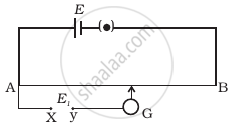
Potential difference between the points A and B in the circuit shown is 16 V, then potential difference across 2Ω resistor is ______ V. volt. (VA > VB)

If you are provided a set of resistances 2Ω, 4Ω, 6Ω and 8Ω. Connect these resistances so as to obtain an equivalent resistance of `46/3`Ω.
In potentiometer experiment, null point is obtained at a particular point for a cell on potentiometer wire x cm long. If the length of the potentiometer wire is increased without changing the cell, the balancing length will ______. (Driving source is not changed)
In balanced meter bridge, the resistance of bridge wire is 0.1 Ω cm. Unknown resistance X is connected in left gap and 6 Ω in right gap, null point divides the wire in the ratio 2:3. Find the current drawn from the battery of 5 V having negligible resistance.
What is the value of resistance for an ideal voltmeter?
What will a voltmeter of resistance 200 Ω read when connected across a cell of emf 2 V and internal resistance 2 Ω?
Draw a neat labelled diagram of Internal resistance of a cell using a potentiometer.
State dimension of potential gradient.
Draw neat labelled diagram of potentiometer as voltage divider.
Three identical cells each of emf 'e' are connected in parallel to form a battery. What is the emf of the battery?
The Figure below shows a potentiometer circuit in which the driver cell D has an emf of 6 V and internal resistance of 2 Ω. The potentiometer wire AB is 10 m long and has a resistance of 28 Ω. The series resistance RS is of 2 Ω.
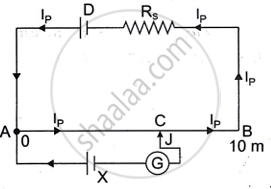
- The current Ip flowing in the potentiometer wire AB when the jockey (J) does not touch the wire AB.
- emf of the cell X if the balancing length AC is 4.5 m.
In a potentiometer, a cell is balanced against 110 cm when the circuit is open. A cell is balanced at 100 cm when short-circuited through a resistance of 10 Ω. Find the internal resistance of the cell.
